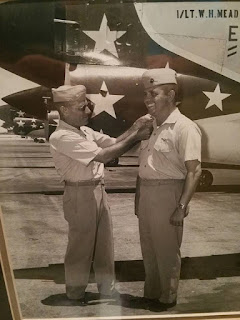 |
William Mead Accepting His Promotion to
1st Lieutenant about June, 1960 |
My brother Bill was a Marine Corps aviator. He went through the Naval Air Cadet (NAVCAD) program, accepting a Marine Corps commission in December 1959. After serving in two Marine fighter squadrons (VMF-122 and VMF-235) and a Marine helicopter squadron (HMM-262), he found himself assigned to the Naval Training Command in Pensacola, Florida. During his time in training squadrons VT-4 and VT-5, he became involved with Barin Field. That's how this story begins.
While serving in Training Wing 5, Bill was told that he would be operating out of Barin Field. Officially, the correct title is "Naval Outlying Field (NOLF) Barin," located near Foley, Alabama. According to Wikipedia, "An auxiliary airfield for NAS Pensacola and NAS Whiting Field, NOLF Barin originally consisted of twin airfield complexes. The West Field was established on the site of the original Foley Municipal Airport that was constructed in the mid-1930s and leased by the U.S. Navy in 1942. An adjoining parcel of 656 acres was also purchased by the Navy for construction of a similar, but not quite reverse, mirror image runway complex that would become known as the East Field.[2] On 2 July 1942, the new facility was designated Naval Auxiliary Air Station (NAAS) Barin Field in honor of Lt. Louis Theodore Barin (20 August 1890 – 12 June 1920), a Navy test pilot and one of the pilots of flying boat NC-1 during the Navy's transatlantic flight in May 1919.
Today, the East Field is still used as NOLF Barin, a satellite airfield for Training Air Wing FIVE (TRAWING 5) at NAS Whiting Field and Training Air Wing SIX (TRAWING 6) at NAS Pensacola. Two runways and the original centerfield flight line complex are still maintained, although the original 1940s/1950s-era hangars and control tower have been demolished and removed."
When my brother was first assigned to fly out of this once abandoned and then reactivated field, the hangars had long since been overgrown with kudzu, partially collapsed, and were unusable. Essentially, there was a usable runway and a "temporary" structure that was used as an operations center. It had all the appearances of a temporary setup. On the runway was painted a section approximately the length of an aircraft carrier, the USS Lexington (CV-16) on which the trainees would make their first arrested landing at sea.
 |
Barin Field East, showing the carrier landing zone
painted on the runway |
When Bill was at Barin Field, student pilots were flying the North American T-28 "Trojan" aircraft. They would prepare by making numerous simulated landings guided by a Landing Signals Officer (LSO) on that painted patch of runway. Only when the trainers felt it was safe were they allowed to fly out into the Gulf of Mexico to land on the Lexington for the first time.
I once asked Bill if he had ever lost a student while at Barin Field. He immediately got very emotional as he described a case in which a student was making a bad approach. Bill advised the student to level out, circle the field, get back in the pattern, and try a new approach. The student ignored his instruction, tried to tighten his turn toward the runway to save the approach, experienced a "low wing stall," and crashed. (In descending turns, the lower wing stalls first.) My brother wondered why the student had ignored his direction and he took the incident very personally.
Bill often talked about Mrs. Gruber's Boarding House in Foley, Alabama, where the staff and students ate lunch practically every day. Apparently Mrs. Gruber took very good care of these future aviators whom she knew would probably be serving off the coast of Viet Nam in the not-too-distant future.
He also spoke of the informality observed at such a remote location. At one point, the squadron was commanded by a Marine Corps Colonel who relaxed the dress code for the training staff. Often, in the searing heat and stifling humidity, Bill went to work in fatigue shorts, a khaki t-shirt, and fatigue cap with his insignia. No long trousers or pressed shirts were required. This led to an amusing story that my brother enjoyed sharing.
It seems that a family from the Midwest was on their way to a Florida vacation in their private Beechcraft Bonanza. They had refueled in Mobile and shortly after takeoff encountered engine trouble. The pilot spotted the runway at Barin and made an emergency landing. He taxied up to the shack and emerged to ask what airport he was at. Entering the shack he noted that the walls were completely papered over with Playboy centerfolds. No one was in any kind of proper military uniform. When told that he had landed at a military base, he could not believe it. They had to convince him of the fact. That's how informal it appeared to an outsider, even though the officers and enlisted staff did their jobs in a very serious manner.
I never got to visit Barin Field while Bill was there. I did get several rides in T-28s. He was obligated to fly a minimum number of cross-country hours per month to maintain his "currency" and would often fly to Norman, Oklahoma, to visit me or take me to Pensacola for a weekend or holiday. I miss the camaraderie that we enjoyed in those visits.











